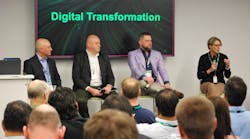As the idea of digital transformation moves industry toward a more efficient and responsible future, it’s important to remember that the process is a journey companies make over many years. It’s not something that happens one day, and an entire production line is digitalized the next, according to Schneider Electric executives, who spoke during the company’s Innovation Days for process control in May at one of its global Hubs in Foxboro, Mass.
The journey, according to Nathalie Marcotte, SVP and president of process and automation at Schneider Electric, is about much more than simply replacing technology. In fact, she said, people are the core of digital transformation and technology, and should be supported despite the often-invoked conventional wisdom that technology is at its center.
“In any digital transformation, we need to put the people in the middle and we're seeing it in many cases,” she said, while speaking on a digital transformation panel with two of her colleagues, Marc Fromager, SVP of industrial automation services, and Elias Panasuik, executive director of EcoStruxure Power and Process.
“When we talk people and digital transformation, a lot of people feel threatened,” she continued. “But what we've learned, what we've seen, is you need both [people and technology].”
At the same time, the digital journey requires a specific end goal, usually tied to efficiency and sustainability. Without domain expertise, digital transformation can simply become cool things without a purpose. “Then it's not going to be helpful, and you're going to be in this proof of concept forever,” Marcotte added.
Fromager agreed and said the first step in the journey is to define the roadmap for ultimate end results. He added one of the most important steps is defining return-on-investment (ROI) guidance for customers. “We can implement a lot of systems, but if that doesn’t generate value, then it doesn't make sense,” he said. “So, what is the level of digitization you actually need?”
Schneider Electric’s goal is to help customers establish the value they need from digitalization. As suppliers of technology solutions, Schneider Electric’s executives said they start with their own supply chain. “This is where we learned it really is a journey,” added Fromager.
The company started the process of transforming its supply chain six years ago. From the start, it found that digitalizing the link between IT and OT is a challenge because IT departments tend to be conservative, primarily for security reasons.
To manage the process, Schneider Electric looked at its opportunity to digitize OT across its approximately 200 sites worldwide. In the end, it came up with a five-step process for its own digital transformation journey, and the executives on the panel said this experience strengthened their ability to help end users with digital transformation.
Know where you want to go
Fromager advised end users to first identify their own expectations for operational efficiency. Factors often involve how many sites need to be covered, as well as which sites make sense to get a digital solution and which don’t.
“As soon as you know where you want to go, [the supplier] needs to know the situation: what’s the data model, how is data acquired, and what’s the status of their OT and IT infrastructure?” Fromager said. “We dive deep into the process with a customer, identify the pain points, and come up with cases that will identify productivity or energy efficiency.”
The next step is implementation, and Fromager said it’s usually done in phases because putting people first in the transformation means change management becomes a very important step. Not to be overlooked is continuous maintenance of solutions implemented, including how revenue is maximized, and the value of the ROI of the digital transformation solutions implemented.
A bigger purpose
The goal of any digital transformation should never be about adding technology just for the sake of adding technology. The implementation of technology must not only answer a business purpose, but also, increasingly, an environmental or social purpose.
Schneider Electric launched EcoStruxure, its open and interoperable architecture and platform, in 2016, with the idea to expand use of the company’s software and hardware technologies to better drive sustainability, automation efficiencies, and energy management. The architecture remains to be the foundation from which Schneider develops its open, data-driven, software-centric portfolio – evolving through different use cases that address customer objectives, such as with capital and operational efficiencies by bringing power and process data together.
“Whether we're looking at the design side and integrating overall design packages in simulation packages to understand interactions between process and electrification, we need to think about how we can link electrical data into the process control network to give the insights that people require, rather than looking at these systems as totally isolated,” said Panasuik.
In many instances, electrical systems and processes are separated, but these days, those interactions have really started to matter in terms of looking at sequencing of events, tracking and disruptions. Panasuik added that Schneider Electric has seen a tremendous push for processes driven by decarbonization an existing process, electrifying a process, carbon capture, or decarbonizing supply chains.
Michael Martinez, Foxboro DCS global leader at Schneider Electric, said there are several projects happening right now concerning electrification of processes. “I know from the process side, specifically, we have to extend the boundaries of what we think of traditionally as a distributed control system to include what will be a very important raw material in the future,” he said. Adding that one of the challenges now is to manage electrification like any other vessel or material that might be brought into a plant.
One thing is certain, digital transformation is not only a journey, but also a new way of thinking about entire processes.





